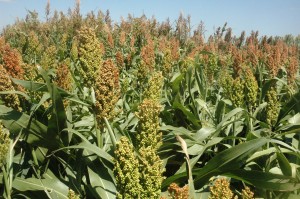Reports are spotty, but growing, experts say

Grain sorghum being grown at the Texas A&M AgriLife Research farm near Bushland.
Texas A&M AgriLife Extension Service entomologists across the state are advising sorghum producers to stay vigilant for fall armyworm infestations.
“This is not a panic situation yet, but a growing number of reports of increasing numbers of fall armyworms from AgriLife Extension entomologists located across the state have led us to warn producers of this possible threat,” said Dr. Charles Allen, AgriLife Extension statewide integrated pest management coordinator at San Angelo.
Fall armyworms are the caterpillar or larval stage of a drab-colored moth with striking translucent white hind wings. The caterpillars can quickly devastate a crop if left unchecked, Allen said. Not much damage occurs when larvae are small, but as larva become full grown damage rapidly increases. The larvae are brownish and relatively smooth-skinned with stripes running the length of the body. Mature caterpillars are about 1.5-2 inches long.
Drs. Pat Porter and Ed Bynum, AgriLife Extension entomologists at Lubbock and Amarillo, respectively, are trying to make sure AgriLife Extension personnel, consultants and farmers are aware of the potential threat to grain sorghum and non-Bt corn in West Texas.
Bynum is running a trapping network for fall armyworms and other pests in the Panhandle.
“Fall armyworm moth captures are unusually high in Lipscomb, Gray, Randall and Swisher counties, and appear to be high across much of the Panhandle,” Bynum said.
“Some whorlstage grain sorghum is being treated in Lubbock and Lynn counties,” Porter said. “My non-Bt corn test plots at Lubbock have at least one fall armyworm per ear. The really troubling thing is that numbers in our fall armyworm traps this past weekend were abnormally high and may reach 1,000 moths per trap this week.
“This is 10 times higher than what we caught this time last year, and this is the July flight. The big flight usually occurs in August. We hope natural enemies and weather will keep them in check, but growers need to be aware that damaging populations may develop and be prepared to deal with them.”
Rick Minzenmayer, AgriLife Extension entomologist for Runnels and Tom Green counties, said fall armyworms and corn earworms are causing increased concern in his area of Central West Texas on both forage and grain sorghums.
“Our grain sorghum looks great and many fields have just finished blooming, but we really need to be watching for headworms (headworm refers to either fall armyworms or corn earworms),” Minzenmayer said. “A simple economic threshold for when control measures are warranted is 12 one-half inch or larger larvae per 25 heads of grain.”
Source : agrilife.org